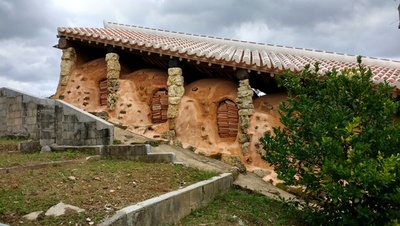National Treasures and Important Cultural Properties in Okinawa

Prior to the 1945 Battle of Okinawa, in which many historical buildings and objects were lost, Okinawa boasted eleven sites (twenty buildings) designated as National Treasures; only Kyoto and Nara prefectures claimed a greater number of National Treasures.[1] Those eleven sites included four temples and shrines (13 buildings); five castles and palaces; and two other stone structures.[2]
Today, there are twelve sites (23 individual buildings) in Okinawa designated as Important Cultural Properties. Six sites of stone structures (incorporating ten individual structures) are Important Cultural Properties today, including three which had previously been designated National Treasures. Five minka sites, incorporating eleven buildings, have been designated as Important Cultural Properties, along with one shrine (two buildings).[2]
A large number of objects associated with the Ryukyuan royal family held at the Naha City Museum of History have been designated, as a group, as a single National Treasure under the name Historical Documents of the Shô Family Kings of Ryûkyû (Ryûkyû kokuô shô ke kankei shiryô). This group includes numerous documents, bingata robes and other textile objects, a number of pieces of lacquerware, pottery, and the like, and several swords. Many other surviving artifacts of great Ryukyuan cultural and historical significance are today housed at the Okinawa Prefectural Museum.
List of Sites & Objects
- Aragaki house and agari-nu-gama pottery kilns in Tsuboya, Naha. Important Cultural Property.
- Engaku-ji - named a National Treasure in 1933; destroyed in 1945. Rebuilt gates and bridge named Important Cultural Property in 1975.
- Collection of Kamakura Yoshitarô's photographs from his survey of Okinawan arts; held by Okinawa Prefectural University of the Arts. Named an Important Cultural Property in 2005.
- Magiri-zu maps, held by Okinawa Prefectural Museum. Important Cultural Property.
- Nakamura House in Nakagusuku Village. Named Important Cultural Property in 1972.
- Naha City Museum of History - Historical Documents of the Shô Family Kings of Ryûkyû, including, among many other objects, the only known surviving Ryukyuan royal investiture crown, and Chiyoganemaru, a 15th century sword formerly owned by the royal family.
- Naminoue Shrine Temple Bell - cast in Korea in 956, named National Treasure in 1907; destroyed 1945. A portion of the top loop survives at the Prefectural Museum.
- Shuri Castle - designated a National Treasure c. 1925; destroyed in 1945. Rebuilt in 1992. Ruins and overall site (other than reconstructions) named a World Heritage Site in 2000.
- Sôgen-ji - designated a National Treasure in 1933; destroyed in 1945. Surviving stone walls & gates are today an Important Cultural Property.
- Oki Shrine (Oki-gû) - designated a National Treasure in 1935, but destroyed in 1945. Rebuilt 1961, and moved to its current location in Onoyama Park in 1975.